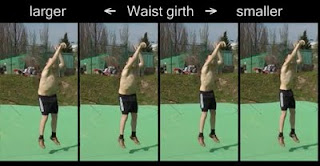Tall & thin, easy on screen
Technology can do anything, Kareena Kapoor could have given yoga and dieting a miss and still managed to look size zero, only if somebody had told her about MovieReshape.
That somebody could have been Indian Scholar Arjun Jain who, sitting in a computer graphics laboratory here, is preparing for the day when Bollywood actors or actresses lose their shine or figure to food, age or whatever – yet directors still want them.
Jain and his colleagues at the Max Planck Institute for Informatics (MPII) in this southwestern German town, which one housed World War II barracks for German soldiers, have developed a software program to reshape at will the images of moving humans.
In a demonstration, an MPII scientist drags a slider on a computer screen and tweaks the weight, waist girth, muscularity, breast size and even leg lengths of images of moving humans, mimicking the exact body movements their changed avatars would display.
“We can make moving people appear fat, thin, heavy, light, short or tall and create movie versions of actor and actresses quite different from their real versions” said Jain who had graduated in Computer Science and Engineering College in Bangalore before he joined the MPII in 2008 as a junior researcher scholar pursuing a PhD.
“With such a program, Abhishek Bachchan need not have put on the weight which he did in Guru and Tom Hanks need not have lost weight for his role in Castaway.” Jain said. The program in called MovieReshape. This program is among the first to be able to rapidly manipulate the body attribute of humans actors in a video, Jain and his senior colleagues Thorsten Thormahlen, Hans-Peter Siedal and Christan Theobalt said in a paper describing their research.
Although commercial and experimental video retouching can achieve somewhat similar effects, the MPII researchers say, no existing technique can deliver what MovieReshape does through a multi-step process: first 3D models of humans are created through multiple laser scans of real humans, these 3D models are projected onto the original images of the humans whose appearance is to be altered, then the slider on the screen is used to tweak individual body features.
“We’re hoping to have impacts beyond computer science through such projects,” said Kurt Melhorn, director of the MPII who also co-directs a collaborative research programme with computer science groups in 10 academic institutions across India, an initiative jointly funded by the Indian and German governments.
Researchers at the MPII have already used computer science techniques to increase the size of the trunk of a car manufactured by a leading German car manufacturer and are now developing a colossal knowledge database named Yago, a repository of 80 million facts — to make searching the web easier.
“A person memorising 3,000 facts every day for 60 years won’t get to 80 million,” said Melhorn. Most search activities are now based on keyword based search but Yago will link facts in the database and facilitate search based on natural language questions.
Melhorn and four of the 10 collaborating groups in India are focusing on algorithms.
“Algorithms underlie all visible end-user computer applications, whether it is searching the web or reshaping movie actors,” said Naveen Garg, codirector of the Indo-Max Planck Centre for Computer Science, inaugurated last year for research and exchange of scientists between India and Germany.
MovieReshape is among the projects now drawing queries. Jain said special-effects producers from the US had examined its capabilities. “Some of the first applications of MovieReshape might emerge in commercials,” said Jain.
He longs to someday work for Bollywood filmmakers, applying software-generated illusions to stretch the primes of ageing actors and actresses. But even Jain knows the limitations of computer graphics. “Facial expressions, emotions, wrinkles, shadow — those are still challenges.”
Article by
G.S. MUDUR
Saarbrucken (Germany)
Recommended site :
Video conferencing – Eyenetwork offers video conference and telepresence facilities including video conferencing rooms, locations, studios and conferencing services in major cities like London, New York, Paris, Sydney and Hong Kong.
Video conferencing systems – Award-winning Video Conference Facilities and Telepresence Provider: We have made Video Conferencing affordable, at a fraction of the cost and inconvenience of business travel.
Content Copyrighted To TechnoWorldNews.com
Latest posts by Techno World News (see all)
- 7 Key Web Design Principles To Create Impactful Web Experiences - June 20, 2024
- Why Your Small Business Needs SEO To Succeed - June 1, 2024
- Ultimate Guide to How Encoders Work: Types & Applications - June 1, 2024






